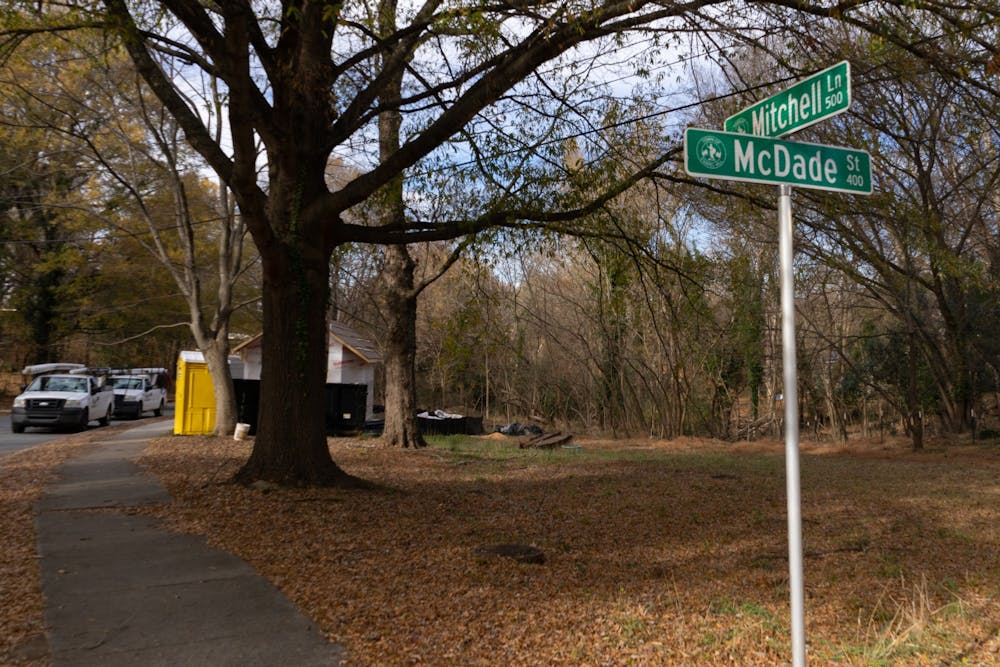In the 1970s, Chapel Hill created a landfill in the Rogers-Eubanks neighborhood in exchange for recreational facilities and infrastructure. The Town did not follow through on the resolution to set aside land for affordable and mixed-income housing as well as low-intensity commercial development on the 164-acre plot of land near Roger-Eubanks called the Greene Tract, until November 2021.
In the Northside community, where Campbell grew up, developers began buying properties in the 1990s and sold them to investors who rented them to students at prices that weren't affordable to residents.
An article called “An Introduction to Northside History” from the Marian Cheek Jackson Center, an organization that works to preserve and build community in Chapel Hill and Carrboro’s historically Black neighborhoods, explains the phenomenon of students beginning to rent housing in Northside.
“Oversize construction, predatory sales, and the emergence of a student rental market that thrived on flagrant violation of occupancy codes followed,” the article states.
In 2004, the Town created the Northside Neighborhood Conservation District, a zoning overlay district which restricts home size to encourage development compatible with the area.
Even so, Northside’s Black population has sharply declined. The Census documents 1,159 Black residents in 1980, which fell to 690 by 2010, according to the Town of Chapel Hill.
Noticing the conversion of single-family homes to rental properties targeting students, the Town Council put in place a development moratorium from 2011 to 2012.
Campbell points to Black Northside residents who, despite the development that displaced them, continued to invest in the community.
“Out of gentrification, we did not just lay down,” Campbell said. “We stood up to try to do as much as we could to say, ‘Hey, see me. We’re here. This is what we’re offering.’”
The off-campus student housing hunt
The University mandates that all first-year students live on campus. When they move off-campus, housing options consist mainly of apartment complexes, luxury apartments and houses.
Last year’s scramble to find off-campus accommodations when the University rapidly switched to remote-only instruction and reduced on-campus student housing posed additional complications to the current student rental landscape.
To get the day's news and headlines in your inbox each morning, sign up for our email newsletters.
UNC senior Charlotte Dorn was one of many students who sought new housing accommodations after the semester pivoted online.
Dorn moved from Lark Chapel Hill, an off-campus apartment complex, to a house on Sunset Drive in the Northside neighborhood. She was connected to the spot through a search that began on a local rental housing website.
She had never rented a house before and didn’t know much about the location. But the house’s rent was much cheaper than her space at Lark, she said.
After Dorn and her two roommates moved into the Northside house, they found out that a family had lived there before them. Graduate student neighbors told them about the previous occupants. They met many neighbors while doing remote classwork from their yard.
She began a self-education process that included taking University classes about gentrification and learning about the history of Northside.
“I am more aware of that and felt a responsibility to understand what as students we could do about that,” Dorn said. “Or what we could do to not worsen the problem.”
What students can do
For students who move to a gentrified area of town without any knowledge of the area or the history, there are ways to make the best of the situation.
Multiple local nonprofit organizations work to preserve the history of Chapel Hill’s historically Black neighborhood and foster mutual respect among long-time residents and students, including the Marian Cheek Jackson Center, the Community Empowerment Fund and EMPOWERment, Inc.
Delores Bailey is the executive director of EMPOWERment, Inc., an organization that focuses on housing justice and economic development in historically Black neighborhoods.
Bailey, who grew up in Northside and currently resides there, won the 2021 Chapel Hill-Carrboro NAACP Dr. Martin Luther King, Jr. Community Service Award. She recommends students get involved with nonprofits and search for ways to help.
One way she said students can be respectful renters includes telling neighbors ahead of time if they’re going to host a party and respecting the property itself.
“To walk in and out and never have any attention to the community is just as much a disservice as leaving your red cups on your front porch and making noise and leaving your trash can out,” Bailey said.
Students can also participate in the Good Neighbor Initiative, a program that promotes respectful relationships between student renters and permanent residents through a door-to-door neighborhood walk and cookout in Northside.
The GNI began in 2004 and is a partnership between UNC, the Towns of Chapel Hill and Carrboro, EMPOWERment, Inc., the Jackson Center and other community partners.
One small action that can have a big impact is simply greeting neighbors, Bailey said.
Chapel Hill resident Keith Edwards expressed similar sentiments in a 2011 oral history interview that focused on gentrification with the Jackson Center’s “History of Homes” initiative. Edwards had lived in the same house on McDade Street in Northside her whole life until she moved to a house built with a Chapel Hill development grant.
Edwards said students move in and bring their own community instead of embracing the one that’s there. She said she generally approaches all the white students walking by, but she’s lucky if one or two speak to her.
“Even though you extend the courtesy because that’s how you were raised and that’s what you do in a community and they don’t give it back to you, that’s a hurting feeling," Edwards said.
@DTHCityState | city@dailytarheel.com | elevate@dailytarheel.com



